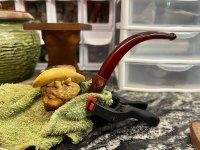I think it is quite possibly amber. The tenon definitely feels and looks like bone. I don’t plan on sending it off. My goal is to do my own restoration work. That’s part of the fun of this adventure. I’ve restored other Meers, usually those tenons were broke. So I had to cut them out and slowly pick pieces out and replace with the Teflon tenons.
Yeah, the problem with amber is that if you start cutting on or twisting that tenon the end of the bit will disintegrate. In order to put a Teflon tenon in your gonna need to counter bore the face of bit to fit around the mortise cap and it most likely wont endure that either. If you're determined to save the bit and you can get the old tenon out replacing it with bone would be the easiest thing to do. if you have small drill chuck you can put the tenon in the chuck and gently but firmly work the tenon back and forth until it loosens up. But if the threads are stripped out of the mortise you gonna need to a tenon thats larger on the shank side. If the pipe was produced in Europe the old threads will be 60deree Whitworth threads and unless you have Whitworth taps your gonna have a hard time finding a tenon that will fit the existing threads in the stem. If your gonna recut the threads in the mortise your gonna need to wax the inside of the mortise to rehydrate the threaded area toe keep it from turning to dust when you start turning the tap.
You can fill the end of the shank with a mixture of meerschaum dust and egg whites and re tap it if you have the right taps, but if the tenon is stuck in the bit you wont be able to clock it.
IF, the bit is cataline and not amber, it will endure a lot more stuff than amber will. Cataline is pretty forgiving.











